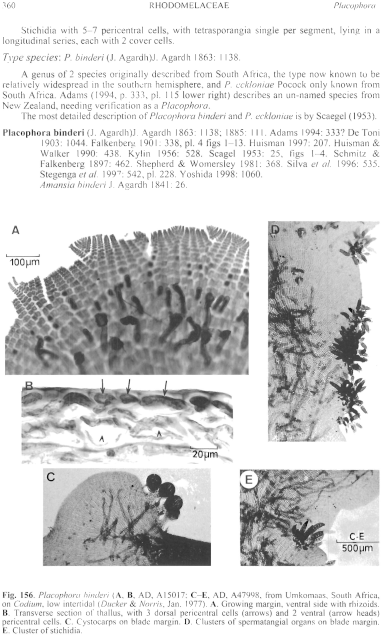|
|
|
|
|
|||||||||||
|
Electronic Flora of South Australia Species Fact Sheet
Phylum Rhodophyta – Family Rhodomelaceae – Tribe Placophora
Selected citations: Adams 1994: 333? De Toni 1903: 1044. Falkenberg 1901: 338, pl. 4 figs 1–13. Huisman 1997: 207. Huisman & Walker 1990: 438. Kylin 1956: 528. Scagel 1953: 25, figs 1–4. Schmitz & Falkenberg 1897: 462. Shepherd & Womersley 1981: 368. Silva et al. 1996: 535. Stegenga et al. 1997: 542, pl. 228. Yoshida 1998: 1060.
Synonym
Amansia binderi J. Agardh 1841: 26.
Thallus prostrate, flat, dark brown-red, 1–2 cm long and 3–6 mm broad, apex rounded, simple or branched, epiphytic on Codium, attached by rhizoids from the ventral pericentral cells. Structure. Margin of numerous apical cells terminating polysiphonous filaments laterally united in the broad thallus apex (Fig. 156A), without trichoblasts (apart from sexual plants). Apical cells squat, flat-topped, 10–16 µm broad and 10–12 µm long, axial cells cutting off 5 pericentral cells dorsiventrally, 3 dorsally and 2 ventrally (Fig. 156B); mature pericentral cells 15–25 µm in diameter and L/D (2–) 3–5. Branching of the main axial cells in alternate pairs, in lateral axes one to several cells apart. Rhizoids cut off from the ventral pericentral cells, 20–30 µm in diameter, penetrating between the Codium utricles. Cells with discoid rhodoplasts.
Reproduction: Unknown in Australian material (the following based on AD, A47998 from Umkomaas, South Africa, on Codium, low eulittoral, Jan. 1977, Coll. Ducker & Norris). Gametophytes dioecious; reproductive organs on short, free, polysiphonous branches bearing trichoblasts, on the thallus margins. Cystocarps (Fig. 156C) ovoid, 180–250 µm in diameter (immature); pericarp ostiolate, ecorticate, 2 cells thick, outer cells isodiametric. Spermatangial organs (Fig. 156D) on trichoblasts, clustered, ovoid-lanceoid, 90–150 µm long and 40–65 µm in diameter, with 3–4 sterile apical cells.
Stichidia (Fig. 156E) in small clusters, cylindrical, 180–360 µm long and 50–70 µm in diameter, with tetrasporangia in a straight row, one per segment, 30–50 µm in diameter, with 2 cover cells.
Type from the Cape of Good Hope, S. Africa; holotype in Herb. Agardh, LD, 42945.
Selected specimens: Elliston, S. Aust., on Codium pomoides lower eulittoral; shaded, just inside bay (Womersley, 15.i.1951; AD, A15017).
Distribution: Elliston, S. Australia.
South Africa, Mozambique, Timor? (see Silva et al. 1996, p. 535). New Zealand.
Taxonomic notes: The above record is the only confirmed one from southern Australia. Placophora, especially when only sterile material is available, has to be observed carefully to separate it from the superficially similar Symphyocladia, the thallus of which is not dorsiventral in section and frequent trichoblasts are present.
Placophora binderi is most commonly epiphytic on Codium, but Seagel (1953, p. 25) records it as epiphytic on several other firm-surfaced algae in South Africa.
References:
ADAMS, N.M. (1994). Seaweeds of New Zealand. (Cant. Univ. Press: Christchurch.)
AGARDH, J.G. (1841). In historiam algarum symbolae. Linnaea 15, 1–50, 443–457.
AGARDH, J.G. (1863). Species Genera et Ordines Algarum. Vol. 2, Part 3, pp. 787–1291. (Gleerup: Lund.)
AGARDH, J.G. (1885). Till algernes systematik. VII. Florideae. Acta Univ. lund. 21, 1–120, Plate 1.
DE TONI, G.B. (1903). Sylloge Algarum omnium hucusque Cognitarum. Vol. 4. Florideae. Sect. 3. pp. 775–1521 + 1523–1525. (Padua.)
FALKENBERG, P. (1901). Die Rhodomelaceen des Golfes von Neapel und der angrenzenden Meeres-abschnitte. Fauna und Flora des Golfes von Neapel. Monogr. 26. (Friedländer: Berlin.)
HUISMAN, J.M. & WALKER, D.I. (1990). A catalogue of the marine plants of Rottnest Island, Western Australia, with notes on their distribution and biogeography. Kingia 1, 349–459.
HUISMAN, J.M. (1997). Marine Benthic Algae of the Houtman Abrolhos Islands, Western Australia. In Wells, F.E. (Ed.) The Marine Flora and Fauna of the Houtman Abrolhos Islands, Western Australia, pp. 177–237. (W. Aust. Museum: Perth.)
KYLIN, H. (1956). Die Gattungen der Rhodophyceen. (Gleerups: Lund.)
SCAGEL, R.F. (1953). A morphological study of some dorsiventral Rhodomelaceae. Univ. Calif. Pubis Bot. 27, 1–108.
SCHMITZ, F. & FALKENBERG, P. (1897). Rhodomelaceae. In Engler, A. & Prantl, K., Die natürlichen Pflanzenfamilien. T.1. Abt. 2, pp. 421–480. (Englemann: Leipzig.)
SHEPHERD, S.A. & WOMERSLEY, H.B.S. (1981). The algal and seagrass ecology of Waterloo Bay, South Australia. Aquat. Bot. 11, 305–371.
SILVA, P.C., BASSON, P.W. & MOE, R.L. (1996). Catalogue of the Benthic Marine Algae of the Indian Ocean. (Univ. California Press: Berkeley.)
STEGENGA, H., BOLTON, J.J. & ANDERSON, R.J. (1997). Seaweeds of the South African West Coast. Contributions from the Bolus Herbarium, No. 18.
YOSHIDA, T. (1998). Marine Algae of Japan. (Uchida Rokakuho Publ. Co.: Tokyo.)
The Marine Benthic Flora of Southern Australia Part IIID complete list of references.
Publication:
Womersley, H.B.S. (24 February, 2003)
The Marine Benthic Flora of Southern Australia
Rhodophyta. Part IIID. Ceramiales – Delesseriaceae, Sarcomeniaceae, Rhodomelaceae
Reproduced with permission from The Marine Benthic Flora of Southern Australia Part IIID 2003, by H.B.S. Womersley. Australian Biological Resources Study, Canberra. Copyright Commonwealth of Australia.
Illustration in Womersley Part IIIA, 2003: FIG. 156.

Figure 156 enlarge
Fig. 156. Placophora binderi (A, B, AD, A15017; C–E, AD, A47998, from Umkomaas, South Africa, on Codium, low intertidal (Ducker & Norris, Jan. 1977). A. Growing margin, ventral side with rhizoids. B. Transverse section of thallus, with 3 dorsal pericentral cells (arrows) and 2 ventral (arrow heads) pericentral cells. C. Cystocarps on blade margin. D. Clusters of spermatangial organs on blade margin. E. Cluster of stichidia.

|
Email Contact: State Herbarium of South Australia |

|